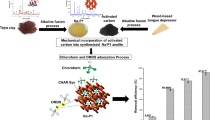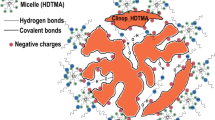Abstract
Development of environmentally acceptable decontaminants of chemical weapons and other highly toxic chemicals is important because of security, economical, health, political, and environmental reasons. The efficiency of natural zeolite (clinoptilolite) and synthetic zeolite, metal oxides, and their mixtures as chemical and physical sorbents of chemical warfare agents (CWA) was investigated. Commonly studied chemical warfare agent simulants dimethyl methylphosphonate (DMMP) and 2-chloroethyl ethyl sulfide (2-CEES) were included in this study. Organic solutions of DMMP and 2-CEES were passed through a column filled with natural and synthetic zeolites and their mixtures with metal oxides. After passing through the column filled with different sorbents, all eluents were filtered and centrifuged before the gas chromatography–mass spectroscopy (GC–MS) analysis. The efficiency of investigated adsorbents was estimated based on the obtained data. All investigated sorbents exhibited absorption efficiency for both simulants of chemical warfare agents. Infrared spectroscopy was used for the detection of DMMP and 2-CEES adsorbed to the investigated adsorbents. Since GC–MS analysis results indicate very good sorption properties of both simulants, the detection of adsorbed CWA simulants was a matter of routine.







Similar content being viewed by others
References
Convention on the prohibition of the development, production, stockpiling and use of chemical weapons and on their destruction (1997), Technical secretariat of the organisation for prohibition of chemical weapons, Den Hag, pp 12–50
Bokan S, Čižmek A, Ilijaš B, Jukić I, Orehovec Z, Radalj Ž (2004) Oružja za masovno uništavanje: nuklearno-kemijsko-biološko i toksinsko oružje. Pučko otvoreno učilište Zagreb, Zagreb, pp 203–293
Marrs TC, Maynard RL, Sidell FR (2007) Chemical Warfare Agents. Wiley, Chichester, pp 1–45
Okumura T, Takasu N, Ishimatsu S, Miyanoki S, Mitsuhashi A, Kumada K, Tanaka K, Hinohara S (1996) Report on 640 victims of the Tokyo subway sarin attack. Ann Emerg Med 28(2):129–135
Sanderson H, Fauser P, Rahbek M, Larsen JB (2014) Review of environmental exposure concentrations of chemical warfare agent residues and associated the fish community risk following the construction and completion of the Nord Stream gas pipeline between Russia and Germany. J Hazard Mater 279:518–526
Bartelt-Hunt SL, Knappe DRU, Barlaz MA (2008) A review of chemical warfare agent simulants for the study of environmental behavior. Crit Rev Environ Sci Technol 38:112
Lavoie J, Srinivasan S, Nagarajan R (2011) Using cheminformatics to find simulants for chemical warfare agents. J Hazard Mater 194:85–91
Matatagui D, Fernández MJ, Fontecha J, Santos JP, Grŕcia I, Cané C, Horrillo MC (2012) Love-wave sensor array to detect, discriminate and classify chemical warfare agent simulants. Sens Actuators B 175:173–178
Kanu AB, Haigh PE, Hill HH (2005) Surface detection of chemical warfare agent simulants and degradation products. Anal Chim Acta 553:148–159
Lucas E, Decker S, Khaleel A, Seitz A, Fultz S, Ponce A, Li W, Carnes C, Klabunde KJ (2001) Nanocrystalline metal oxides as unique chemical reagents/sorbents. Chem Eur J 12:2505–2510
Wingenfelder U, Nowack B, Furrer G, Schulin R (2005) Adsorption of Pb and Cd by amine-modified zeolite. Water Res 39(14):3287–3297
Stelmaszuk W (2003) Activated carbon for removal of organophosphorus and organofluorine chemical warfare agents from water. Ekotekhnolii i Resursos Berezhenie 6:56–63
Inel O, Albayrak F, Askin A (1998) Cu and Pb adsorption on same bentonitic clays. Turk J Chem 22(3):243–252
Meena AK, Mishra GK, Kumar S, Rajagopal C (2004) Low cost adsorbents for the removal of mercury(II) from aqueous solution: a comparative study. Def Sci J 54(4):537–548
Vučemilović A, Hadžija M, Jukić I (2008) Efficacy of mineral cationic carrier against sulfur mustard in skin decontamination. Arch Ind Hyg Toxicol 59:173–177
Selbe J (2005) Applications of aluminosilicate and zincosilicate materials: aqueous phase ion exchange and gas phase adsorption. PhD Dissertation, Kansas State University
Grassian VH, Larsen SC (2009) Applications of nanocrystalline zeolites to CWA decontamination. In: Nagarajan R, Zukas W, Hatton TA, Lee S (eds) Nanoscience and nanotechnology for chemical and biological defense. ACS Symposium Series Book; American Chemical Society, Washington, DC, pp 1–9
Knagge K, Johnson M, Grassian VH, Larsen SC (2006) Adsorption and thermal oxidation of DMMP in nanocrystalline NaY. Langmuir 22:11077–11084
Zander NE, Kowalski E, Rawlett AM and Orlicki JA (2007) Decontamination of chemical agent simulant by nanometal oxides, Weapons and Materials Research Directorate, ARL, United States Military Academy, ARL-TR-4133, pp 1–9
Saxena A, Srivastavab AK, Singhb B, Goyal A (2012) Removal of sulphur mustard, sarin and simulants on impregnated silica nanoparticles. J Hazard Mater 211–212:226–232
Brickhouse MD, Lalain TA, D’Onofrio TG, Procell LR and Zander ZB (2007) Evaluation of silver-exchanged zeolites under development by university of maine for chemical warfare agent decontamination applications, Edgewood Chemical Biological Center Aberdeen proving ground, pp 2–7
Prasad GK, Ramacharyulu PV, Singh B (2011) Nanomaterials based decontaminants against chemical warfare agents. Am J Sci Ind Res 70:91–104
Ram MK and Kumar A, (2010) Decontamination using nanotechnology, Nanotechnology Education Research Center, University of South Florida, Tampa, pp 4–20
Hirakawa T, Sato K, Komano A, Kishi S, Nishimoto CK, Mera N, Kugishima M, Sano T, Negishi N, Ichinose H, Seto Y, Takeuchi K (2013) Specific properties on TiO2 photocatalysis to decompose isopropyl methylphosphonofluoridate and dimethyl methylphosphonate in gas phase. J Photochem Photobiol A 264:12–17
Pragney D, Saradhi UVRV (2012) Sample-preparation techniques for the analysis of chemical warfare agents and related degradation products. Trends Anal Chem 37:73–82
Fichtner S, Hofmann J, Möller A, Schrage C, Giebelhausen JM, Böhringer B, Gläser R (2013) Decomposition of 2-chloroethylethylsulfide on copper oxides to detoxify polymer-based spherical activated carbons from chemical warfare agents. J Hazard Mater 262:789–795
Bielicka-Daszkiewicz K, Voelkel A (2009) Theoretical and experimental methods of determination of the breakthrough volume of SPE sorbents. Talanta 80:614–621
Rodriguez I, Llompart MP, Cela R (2000) Solid-phase extraction of phenols. J Chromatogr A 885:291–304
Ćurković L, Cerjan-Stefanović Š, Filipan T, Modrić M (1999) Utjecaj obrade prirodnog zeolita na djelotvornost uklanjanja bakrovih(II) iona. Kem Ind 48:441–445
Mitchell MB, Sheinker VN, Mintz EA (1997) Adsorption and decomposition of dimethyl methylphosphonate on metal oxides. J Phys Chem B 101:11192–11203
Sharma N, Kakkar R (2013) Recent advancements on warfare agents/metal oxides surface chemistry and their simulation study. Adv Mater Lett 4(7):508–521
Abelard J, Wilmsmeyer AR, Edwards AC, Gordon WO, Durke EM, Karwacki CJ, Troya D, Morris JR (2014) Adsorption of 2-chloroethyl ethyl sulfide on silica: sorption mechanism and energy of a bifunctional hydrogen-bond acceptor at the gas–surface interface. J Phys Chem C 119(1):365–372
Mattsson A, Lejon C, Štengl V, Bakardjieva S, Opluštil F, Andersson PO, Österlund L (2009) Photodegradation of DMMP and CEES on zirconium doped titania nanoparticles. Appl Catal B 92(3):401–410
Kiselev A, Mattson A, Andersson M, Palmqvist AE, Österlund L (2006) Adsorption and photocatalytic degradation of diisopropylfluorophosphate and dimethyl methylphosphonate over dry and wet rutile TiO2. J Photochem Photobiol A 184(1):125–134
Bermudez VM (2005) Adsorption on carbon nanotubes studied using polarization-modulated infrared reflection-absorption spectroscopy. J Phys Chem B 109(20):9970–9979
Bowen JM, Powers CR, Ratcllffe AE, Rockley MG, Hounslow AW (1988) Fourier transform infrared and Raman spectra of dimethyl methylphosphonateadsorbed on montmorillonite. Environ Sci Technol 22:1178–1181
Stout SC, Larsen SC, Grassian VH (2007) Adsorption, desorption and thermal oxidation of 2-CEES on nanocrystalline zeolites. Microporous Mesoporous Mater 100:77–86
Österlund L, Štengl V, Mattsson A, Bakardjieva S, Andersson PO, Opluštil F (2009) Effect of sample preparation and humidity on the photodegradation rate of CEES on pure and Zn doped anatase TiO2 nanoparticles prepared by homogeneous hydrolysis. Appl Catal B 88(1):194–203
Kim DB, Gweon B, Moon SY, Choe W (2009) Decontamination of the chemical warfare agent simulant dimethyl methylphosphonate by means of large-area low-temperature atmospheric pressure plasma. Curr Appl Phys 9:1093–1096
Ruiz-Pesante O, Pacheco-Londoño LC, Primera-Pedrozo OM, Ortiz W, Soto-Feliciano YM, Nieves DE, Ramirez ML and Hernández-Rivera SP (2007) Detection of simulants and degradation products of chemical warfare agents by vibrational spectroscopy, Defense and Security Symposium, International Society for Optics and Photonics
Yan F, Stokes DL, Wabuyele MB, Griffin GD, Vass AA and Vo-Dinh T (2004) Surface-enhanced Raman scattering (SERS) detection for chemical and biological agents, Biomedical Optics, International Society for Optics and Photonics
Author information
Authors and Affiliations
Corresponding author
Ethics declarations
Conflicts of interest
The authors declare that they have no conflict of interest.
Rights and permissions
About this article
Cite this article
Tušek, D., Ašperger, D., Bačić, I. et al. Environmentally acceptable sorbents of chemical warfare agent simulants. J Mater Sci 52, 2591–2604 (2017). https://doi.org/10.1007/s10853-016-0552-x
Received:
Accepted:
Published:
Issue Date:
DOI: https://doi.org/10.1007/s10853-016-0552-x




